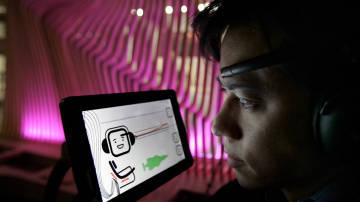Last summer, employees of the
small Toronto tech company InteraXon were sitting in their Dundas
Street West office, conjuring ways to exploit their mind-controlling
technology. Maybe they could use their brainwave sensors to build some
kind of telekinetic musical instrument made with singing glass bowls?
Or a thought-driven heat lamp?
But the Ontario government came up with the brightest master plan.
Acting on a non-extrasensory tip from the Ministry of Research and
Innovation, the Ministry of Tourism contacted them, asking if they had
the power to illuminate the CN Tower.
“We thought about it for a minute and went, ‘Well, I guess so, yeah.
Let's do it,' ” recalls Trevor Coleman, one of InteraXon's founders.
A few days later the ministry came back again and asked if they
could do something with Niagara Falls and Parliament Hill, too. In what
will be their biggest venture to date, InteraXon will use its special
technology to send brainwaves from the pavilion at the Vancouver Olympics to those three landmarks back east.
to those three landmarks back east.
“They also wanted us to light up the ice-fishing huts in North Bay,”
reports Mr. Coleman, “but we thought that would be a little too much …
scope.”
Previously, they built items such as a thought-controlled video game
where players race rocket ships using beta waves – a big hit in the
club scene.
Then there's the chair that levitates when you reach a meditative brain-state.
When visitors to the Ontario Pavilion next month put on the
headphone-like brainwave sensors, their mental activity will be
communicated to control systems that light up each of the sites. Slow
your mind and the lights dim as the brain starts producing
lower-frequency alpha waves. Higher-frequency beta waves of an alert
mind make the lights come to life – comet trails stream down the shaft
of the CN Tower; backlit Niagara Falls starts to glow in shades of
purple and red; Parliament Hill springs out of the shadows.
“[The data] can be pretty difficult to master at first,” explains
project engineer Chris Aimone, an unobtrusive sensor resting over his
forehead as he watches a graphic readout of his thought patterns
coruscating across a white monitor.
The three-person company grew out of an eclectic crowd of artists
and engineering students working under the tutelage of Steve Mann, a
engineering professor at the University of Toronto and a
self-proclaimed cyborg.
Project leader Ariel Garten, 30, a fashion designer and practising
psychotherapist who holds a degree in neuroscience, first got involved
with a brainwave jazz concert with several of Mr. Mann's students back
in 2003, when dozens of audience members were wired up to EEG sensors
used to modulate the musicians' electric instruments. “When I saw this
technology, I thought, ‘Something needs to be done with it.' ”
Later she teamed up with Mr. Aimone, 31, a talented designer with a
background in electrical engineering, and Mr. Coleman, 29, a former
club promoter with a flare for business. “We have an insane amount of
creativity on this team,” says Ms. Garten, who is wearing a pair of
rainbow-striped rubber boots and sitting on a fun-fur-covered
teeter-totter in the corner of their warehouse-lab amid an impressive
array of powerful computers, sophisticated electronics and empty
Pizzaiolo boxes.
She says their diversity gives them an edge when it comes to
exploring this new technology. “It allows us to come up with funny
ideas and weird ideas and the right ideas. … Something that both
functions technologically, is sound scientifically, is aesthetically
pleasing, engages emotionally. All of those different things,” she
says. “How do we do that? I don't know, at five in the morning?”
The project with the Ontario government, which has a mid-six-figure
budget, was a big score for the company, catapulting their fledgling
business from the thick ether of ideas to front-stage reality. But
apart from the exposure, the best part about going to the Olympics,
they say, is the ideas they get to spark.
“One of the things we think is really important is kind of being
evangelists for this technology,” says Mr. Coleman. “Every time someone
has the experience for the first time and they control something with
their mind – a levitating chair or a toy car in a track – they
immediately come up with 10 new ideas, right there.”
Special to The Globe and Mail






Join the Discussion: